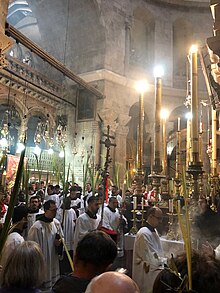Sacramental

A sacramental (Latin pl. sacramentalia) is a sacred sign, a ritual act or a ceremony, which, in a certain imitation of the sacraments, has a spiritual effect and is obtained through the intercession of the Church.[1] Sacramentals surround the sacraments like a wreath and extend them into the everyday life of Christians. Sacramentals are recognised by the Catholic Church, the Eastern Orthodox Church, the Oriental Orthodox Churches, the Church of the East, the Lutheran churches, the Old Catholic Church, the Anglican churches, and Independent Catholic churches.
In the Bible, prayer cloths and holy oil are mentioned in reference to praying for healing.[2][3] Holy water is a sacramental that the faithful use to recall their baptism; other common sacramentals include blessed candles (given to the faithful on Candlemas), blessed palms (blessed on the beginning of the procession on Palm Sunday), blessed ashes (bestowed on Ash Wednesday), a cross necklace (often taken to be blessed by a pastor before daily use), a headcovering (worn by women, especially during prayer and worship), blessed salt, and holy cards, as well as Christian art, especially a crucifix.[4][5] Apart from those worn daily, such as a cross necklace or devotional scapular, sacramentals such as a family Bible, are often kept on home altars in Christian households.[6][7] When blessed in a betrothal ceremony, engagement rings become a sacramental.[8]
As an adjective, sacramental means "of or pertaining to sacraments".
Biblical basis
[edit]The Biblical basis for the use of sacramentals is that Jesus Christ used a form of sacramentals himself; for example, when he healed a blind man, he made a mud paste that he put over the eyes of the man, before telling him to wash in the Pool of Siloam.[9]
Prayer cloths and holy oil are mentioned in reference to praying for healing, as in Acts 19:11–12 and James 5:14–15.[2][3]
Denominational usage
[edit]Catholic
[edit]
The Roman Catholic Church currently defines sacramentals as "sacred signs which ... signify effects, particularly of a spiritual nature, which are obtained through the intercession of the Church. By them men are disposed to receive the chief effect of the sacraments, and various occasions in life are rendered holy".[10]
Sacramentals do not confer the grace of the Holy Spirit in the way that the sacraments do, but by the Church's prayer, they prepare one to receive grace and dispose a person to cooperate with it. "For well-disposed members of the faithful, the liturgy of the sacraments and sacramentals sanctifies almost every event of their lives with the divine grace which flows from the Paschal mystery of the Passion, Death, and Resurrection of Christ. From this source all sacraments and sacramentals draw their power."[11]
The Catechism of the Catholic Church lists three types of sacramentals: blessings,[12] consecrations and dedications,[13] and exorcisms.[14]
Rosary beads, scapulars, medals and religious images are more accurately termed devotional articles; prayers such as the rosary, the stations of the cross, litanies, and novenas are called popular devotions or "expressions of popular piety".[15]
The Latin Church allows the bestowing of certain sacramentals, such as blessings, "to catechumens and even to non-Catholics unless there is a prohibition of the Church to the contrary.[16]
Lutheran
[edit]In Lutheran churches, sacramentals such as palms and crosses, are used by the faithful.[17]
Anglican
[edit]
A text of the Episcopal Church in the United States of America includes items such as the Anglican rosary, ashes, and palms among objects counted as sacramentals.[18]
Pentecostal
[edit]
Pentecostal theologian Mark Pearson states that the Bible speaks of sacramentals, sometimes referred to as points of contact, such as blessed prayer cloths (Acts 19:11–19:12) and holy oil (James 5:14).[2] He states that God is the source of healing and that Pentecostal clergy "can confidently offer prayer, administer the various sacramentals, and lay hands on the sick".[2]
Further reading
[edit]- Deharbe, Joseph (1912). . A Complete Catechism of the Catholic Religion. Translated by Rev. John Fander. Schwartz, Kirwin & Fauss.
- Leclercq, Henri (1913). . Catholic Encyclopedia.
- . Encyclopædia Britannica. Vol. 23 (11th ed.). 1911.
References
[edit]- ^ "Code of Canon Law - Book IV - Function of the Church (Cann. 1166)". www.vatican.va.
- ^ a b c d Payne, Leanne (1 March 1996). Restoring the Christian Soul: Overcoming Barriers to Completion in Christ through Healing Prayer. Baker Books. p. 277. ISBN 978-1-4412-3957-0.
- ^ a b Pearson, Mark (2004). Christian Healing: A Practical and Comprehensive Guide. Charisma Media. p. 153. ISBN 978-1-59185-629-0.
In Scripture and Church tradition, we read of blessed prayer cloths and holy oil (Acts 19:11-12; James 5:14). ... The historical term in the Church for these things is sacramentals.
- ^ Experiencing Religion: New Approaches to Personal Religiosity. LIT Verlag Münster. 2016. p. 125. ISBN 978-3-643-90727-1.
Clara Saraiva, Peter Jan Margry, Lionel Obadia, Kinga Povedák, José Mapril
- ^ Myers, Ryleigh (20 September 2018). "Sound Board: Why I veil". Roman Catholic Diocese of Buffalo. Archived from the original on 11 August 2022. Retrieved 19 March 2023.
- ^ Nelson, Paul A. "Home Altars". Immanuel Lutheran Church. Retrieved 14 April 2018.
- ^ Turpin, Joanne (1 June 1993). Catholic Treasures New and Old: Traditions, Customs and Practices. St. Anthony Messenger Press. pp. 49–50. ISBN 978-0-86716-164-9.
- ^ Marriage Mass & Rite of Betrothal. Angelus Press. 1962.
- ^ O'Neill, Eddie (1 November 2014). "What Are Sacramentals?". Our Sunday Visitor. Archived from the original on 8 August 2018. Retrieved 14 March 2017.
- ^ Sacrosanctum Concilium 60
- ^ Catechism of the Catholic Church § 1670
- ^ Catechism of the Catholic Church § 1671
- ^ Catechism § 1672.
- ^ Catechism § 1673.
- ^ Catechism § 1674.
- ^ Code of Canon Law 1170
- ^ Kavouras, Dean. "Blessed Is He - Blessed Are We". Christ Lutheran Church.
- ^ Armentrout, Don S. (1 January 2000). An Episcopal Dictionary of the Church: A User-Friendly Reference for Episcopalians. Church Publishing, Inc. p. 541. ISBN 978-0-89869-701-8. Retrieved 9 April 2014.
